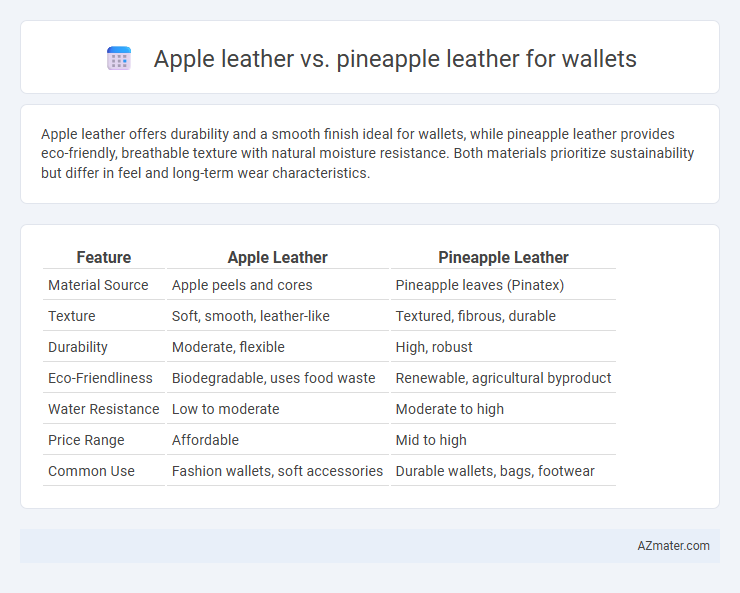Apple leather offers durability and a smooth finish ideal for wallets, while pineapple leather provides eco-friendly, breathable texture with natural moisture resistance. Both materials prioritize sustainability but differ in feel and long-term wear characteristics.
Table of Comparison
| Feature | Apple Leather | Pineapple Leather |
|---|---|---|
| Material Source | Apple peels and cores | Pineapple leaves (Pinatex) |
| Texture | Soft, smooth, leather-like | Textured, fibrous, durable |
| Durability | Moderate, flexible | High, robust |
| Eco-Friendliness | Biodegradable, uses food waste | Renewable, agricultural byproduct |
| Water Resistance | Low to moderate | Moderate to high |
| Price Range | Affordable | Mid to high |
| Common Use | Fashion wallets, soft accessories | Durable wallets, bags, footwear |
Introduction to Plant-Based Leathers
Plant-based leathers such as apple leather and pineapple leather offer sustainable alternatives to traditional animal leather, utilizing fruit waste to create eco-friendly materials. Apple leather, made from apple peels and cores, provides a soft texture and durability ideal for wallets, while pineapple leather, derived from pineapple leaves through the Pinatex process, showcases a distinctive fibrous texture and high breathability. These innovative leathers contribute to reducing textile waste and lowering carbon footprints in the fashion industry.
What is Apple Leather?
Apple leather is an innovative, eco-friendly material made from the byproducts of apple juice production, primarily apple peels and cores, which are processed into a durable, leather-like textile. This sustainable alternative offers breathability, flexibility, and a natural texture that mimics traditional leather without relying on animal products. Often used in wallets, apple leather provides a cruelty-free, biodegradable option with a lower environmental footprint compared to conventional leather.
What is Pineapple Leather?
Pineapple leather, also known as Pinatex, is an innovative sustainable material made from pineapple leaf fibers, offering an eco-friendly alternative to traditional leather. Unlike Apple leather, derived from apple waste, pineapple leather utilizes agricultural byproducts that would otherwise be discarded, reducing environmental impact. This plant-based leather boasts durability and breathability, making it a popular choice for wallets seeking both style and sustainability.
Production Process: Apple vs Pineapple Leather
Apple leather production begins with apple waste such as peels and cores, which are dried, ground into a powder, and combined with a biodegradable polyurethane binder to create a durable, flexible material. Pineapple leather, also known as Pinatex, is made from the cellulose fibers extracted from pineapple leaves, which are processed through clean water and mechanical means, then layered and treated with bio-based coatings to form a sustainable leather alternative. Both materials avoid animal products, but pineapple leather utilizes agricultural byproducts from leaf remnants, making it highly sustainable with minimal chemical processing compared to the fruit-based apple leather production.
Sustainability and Environmental Impact
Apple leather and pineapple leather represent innovative sustainable alternatives to traditional animal leather, each with distinct environmental benefits. Apple leather is crafted from apple waste, reducing food industry byproducts and minimizing landfill waste, while pineapple leather, known as Pinatex, uses pineapple leaf fibers, promoting agricultural waste upcycling and supporting circular economy practices. Both materials lower carbon footprints and water usage substantially compared to conventional leather tanning, making them eco-friendly choices for wallet manufacturing aimed at reducing environmental impact.
Durability and Longevity for Wallets
Apple leather exhibits strong durability and resistance to wear, making it an excellent choice for wallets that require long-lasting use. Pineapple leather, derived from Pinatex, offers moderate durability with a unique texture but may experience quicker surface wear over time. For wallets prioritizing longevity, apple leather generally provides superior resilience against daily stress and environmental factors.
Texture and Aesthetic Differences
Apple leather features a smooth, supple texture with a consistent grain that mimics traditional genuine leather, offering a sleek and polished aesthetic ideal for wallets. Pineapple leather, derived from pineapple fibers, has a more fibrous, slightly coarse texture with natural variations that create a distinctive, rustic look. The tactile contrast between apple leather's refined finish and pineapple leather's organic character significantly influences the wallet's visual appeal and user experience.
Wallet Design Versatility
Apple leather offers flexible texture and a smooth finish that adapts well to various wallet designs, from sleek minimalist to intricate patterns. Pineapple leather features a natural grain and firmness that enhances structural integrity, ideal for wallets requiring durable and unique aesthetics. Both materials support sustainable fashion trends while allowing designers to explore diverse forms and functionalities in wallet creation.
Cost Comparison and Market Availability
Apple leather typically costs more than pineapple leather due to its more complex production process and limited raw material supply, affecting wallet pricing. Pineapple leather, derived from pineapple leaf fibers, offers a more affordable alternative with increasing market availability thanks to sustainable farming byproducts. Both materials are gaining traction in eco-friendly wallets, but pineapple leather wallets are generally more accessible and budget-friendly for consumers.
Which Plant-Based Leather Is Best for Wallets?
Apple leather offers a soft, durable texture with a smooth finish, making it ideal for wallets that require flexibility and longevity. Pineapple leather, derived from Pinatex, is highly resistant to water and abrasion, providing exceptional durability for everyday use. Choosing the best plant-based leather depends on preferences for texture and resilience, with Apple leather excelling in softness and Pineapple leather in toughness.

Infographic: Apple leather vs Pineapple leather for Wallet
 azmater.com
azmater.com